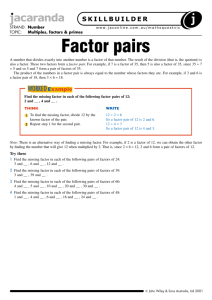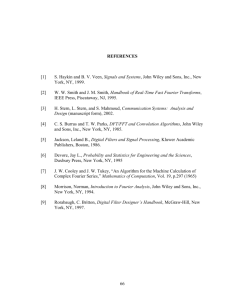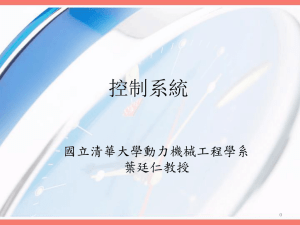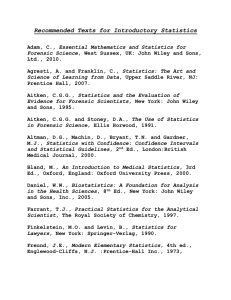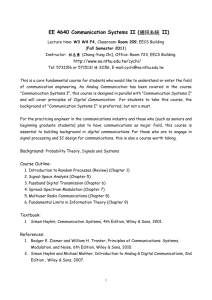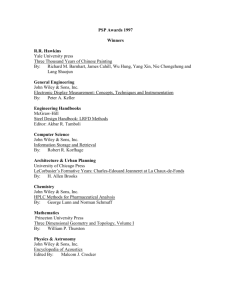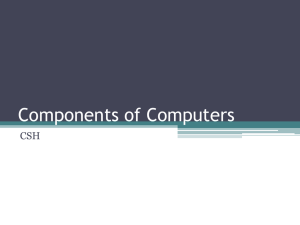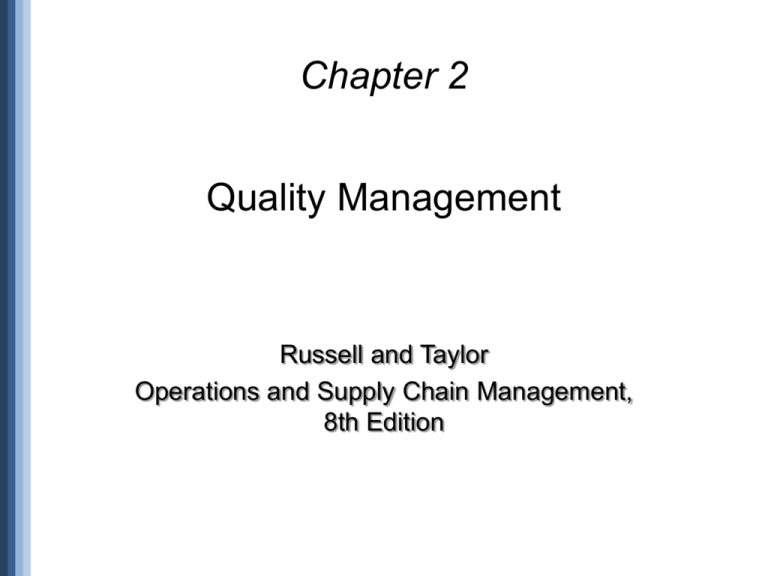
Chapter 2
Quality Management
Russell and Taylor
Operations and Supply Chain Management,
8th Edition
Lecture Outline - 1
•
•
•
•
•
•
What Is Quality? – Slide 5
Quality Management Systems – Slide 16
Quality Tools – Slide 22
TQM and QMS – Slide 31
Focus of Quality Management – Slide 32
Role of Employees in Quality Improvement –
Slide 35
© 2014 John Wiley & Sons, Inc. - Russell and Taylor 8e
2-2
Lecture Outline - 2
•
•
•
•
Quality in Services – Slide 38
Six Sigma – Slide 40
Cost of Quality – Slide 52
Effect of Quality Management on Productivity
– Slide 61
• Quality Awards – Slide 82
• ISO 9000 – Slide 85
© 2014 John Wiley & Sons, Inc. - Russell and Taylor 8e
2-3
Learning Objectives
• Discuss and define the dimensions of quality.
• Articulate the benefits and costs of good quality, and the
costs of poor quality
• Understand how quality management systems have
evolved and be able to assess the stage of quality
evolution a particular company exhibits.
• Utilize quality tools and the DMAIC methodology in
problem solving
• Explain the philosophy and magnitude of six sigma
quality
• Recognize quality awards and ISO certifications
© 2014 John Wiley & Sons, Inc. - Russell and Taylor 8e
2-4
What Is Quality?
• Oxford American Dictionary
• a degree or level of excellence
• American Society for Quality
• totality of features and characteristics that
satisfy needs without deficiencies
• Consumer’s and producer’s perspective
© 2014 John Wiley & Sons, Inc. - Russell and Taylor 8e
2-5
What Is Quality:
Customer’s Perspective
• Fitness for use
• how well product or service does what it is supposed to
• Quality of design
• designing quality characteristics into a product or service
• A Mercedes and a Ford are equally “fit for use,” but with different
design dimensions.
© 2014 John Wiley & Sons, Inc. - Russell and Taylor 8e
2-6
Dimensions of Quality:
Manufactured Products
• Performance
• basic operating characteristics of a product; how
well a car handles or its gas mileage
• Features
• “extra” items added to basic features, such as a
stereo CD or a leather interior in a car
• Reliability
• probability that a product will operate properly
within an expected time frame; that is, a TV will
work without repair for about seven years
© 2014 John Wiley & Sons, Inc. - Russell and Taylor 8e
2-7
Dimensions of Quality:
Manufactured Products
• Conformance
• degree to which a product meets pre–established
standards
• Durability
• how long product lasts before replacement; with
care, L. L. Bean boots may last a lifetime
• Serviceability
• ease of getting repairs, speed of repairs, courtesy
and competence of repair person
© 2014 John Wiley & Sons, Inc. - Russell and Taylor 8e
2-8
Dimensions of Quality:
Manufactured Products
• Aesthetics
• how a product looks, feels, sounds, smells, or tastes
• Safety
• assurance that customer will not suffer injury or harm
from a product; an especially important consideration
for automobiles
• Perceptions
• subjective perceptions based on brand name,
advertising, etc.
© 2014 John Wiley & Sons, Inc. - Russell and Taylor 8e
2-9
Dimensions of Quality: Services
• Time and timeliness
• how long must a customer wait for service,
and is it completed on time?
• is an overnight package delivered overnight?
• Completeness:
• is everything customer asked for provided?
• is a mail order from a catalogue company
complete when delivered?
© 2014 John Wiley & Sons, Inc. - Russell and Taylor 8e
2-10
Dimensions of Quality: Service
• Courtesy:
• how are customers treated by employees?
• are catalogue phone operators nice and are their
voices pleasant?
• Consistency
• is same level of service provided to each customer
each time?
• is your newspaper delivered on time every morning?
© 2014 John Wiley & Sons, Inc. - Russell and Taylor 8e
2-11
Dimensions of Quality: Service
• Accessibility and convenience
• how easy is it to obtain service?
• does service representative answer you calls quickly?
• Accuracy
• is service performed right every time?
• is your bank or credit card statement correct every
month?
• Responsiveness
• how well does company react to unusual situations?
• how well is a telephone operator able to respond to a
customer’s questions?
© 2014 John Wiley & Sons, Inc. - Russell and Taylor 8e
2-12
What Is Quality:
Producer’s Perspective
• Quality of conformance
• making sure product or service is produced
according to design
• if new tires do not conform to specifications, they
wobble
• if a hotel room is not clean when a guest checks
in, hotel is not functioning according to
specifications of its design
© 2014 John Wiley & Sons, Inc. - Russell and Taylor 8e
2-13
Meaning of Quality
© 2014 John Wiley & Sons, Inc. - Russell and Taylor 8e
2-14
What Is Quality:
A Final Perspective
• Customer’s and producer’s perspectives
depend on each other
• Producer’s perspective:
• production process and COST
• Customer’s perspective:
• fitness for use and PRICE
• Customer’s view must dominate
© 2014 John Wiley & Sons, Inc. - Russell and Taylor 8e
2-15
Evolution of Quality Management:
Quality Gurus
• Walter Shewhart
• In 1920s, developed control charts
• Introduced term “quality assurance”
• W. Edwards Deming
• Developed courses during WW II to teach statistical qualitycontrol techniques to engineers and executives of military
suppliers
• After war, began teaching statistical quality control to Japanese
companies
• Joseph M. Juran
• Followed Deming to Japan in 1954
• Focused on strategic quality planning
• Quality improvement achieved by focusing on projects to solve
problems and securing breakthrough solutions
© 2014 John Wiley & Sons, Inc. - Russell and Taylor 8e
2-16
Evolution of Quality Management:
Quality Gurus
• Armand V. Feigenbaum
• In 1951, introduced concepts of total quality control and
continuous quality improvement
• Philip Crosby
• In 1979, emphasized that costs of poor quality far outweigh cost
of preventing poor quality
• In 1984, defined absolutes of quality management—
conformance to requirements, prevention, and “zero defects”
• Kaoru Ishikawa
• Promoted use of quality circles
• Developed “fishbone” diagram
• Emphasized importance of internal customer
© 2014 John Wiley & Sons, Inc. - Russell and Taylor 8e
2-17
Deming’s 14 Points
1.
2.
3.
4.
5.
Create constancy of purpose
Adopt philosophy of prevention
Cease mass inspection
Select a few suppliers based on quality
Constantly improve system and workers
© 2014 John Wiley & Sons, Inc. - Russell and Taylor 8e
2-18
Deming’s 14 Points
6.
7.
8.
9.
10.
Institute worker training
Instill leadership among supervisors
Eliminate fear among employees
Eliminate barriers between departments
Eliminate slogans
© 2014 John Wiley & Sons, Inc. - Russell and Taylor 8e
2-19
Deming’s 14 Points
11. Eliminate numerical quotas
12. Enhance worker pride
13. Institute vigorous training and education
programs
14. Develop a commitment from top management
to implement above 13 points
© 2014 John Wiley & Sons, Inc. - Russell and Taylor 8e
2-20
Deming Wheel: PDCA Cycle
© 2014 John Wiley & Sons, Inc. - Russell and Taylor 8e
2-21
Quality Tools
• Process Flow Chart
• Cause-and-Effect
Diagram
• Check Sheet
• Pareto Analysis
© 2014 John Wiley & Sons, Inc. - Russell and Taylor 8e
• Histogram
• Scatter Diagram
• Statistical Process
Control Chart
2-22
Flow Chart
• A diagram of the steps in a process
• Helps focus on location of problem in a process
© 2014 John Wiley & Sons, Inc. - Russell and Taylor 8e
2-23
Cause-and-Effect Diagram
• Cause-and-effect diagram (“fishbone” diagram)
– chart showing different categories of problem
causes
© 2014 John Wiley & Sons, Inc. - Russell and Taylor 8e
2-24
Cause-and-Effect Matrix
• Cause-and-effect matrix
– grid used to prioritize causes of quality problems
© 2014 John Wiley & Sons, Inc. - Russell and Taylor 8e
2-25
Check Sheets and Histograms
• Tally number of defects
from a list of causes
• Frequency diagram of
data for quality problem
© 2014 John Wiley & Sons, Inc. - Russell and Taylor 8e
2-26
Pareto Analysis
• Pareto analysis
– most quality problems result from a few causes
© 2014 John Wiley & Sons, Inc. - Russell and Taylor 8e
2-27
Pareto Chart
© 2014 John Wiley & Sons, Inc. - Russell and Taylor 8e
2-28
Scatter Diagram
• Graph showing relationship between 2 variables
in a process
• Identifies pattern that may cause a quality
problem
© 2014 John Wiley & Sons, Inc. - Russell and Taylor 8e
2-29
Control Chart
• A chart with statistical upper and lower limits
• If sample statistics remain between these limits we
assume the process is in control
© 2014 John Wiley & Sons, Inc. - Russell and Taylor 8e
2-30
TQM and QMS
• Total Quality Management (TQM)
• customer-oriented, leadership, strategic
planning, employee responsibility, continuous
improvement, cooperation, statistical methods,
and training and education
• Quality Management System (QMS)
• system to achieve customer satisfaction that
complements other company systems
© 2014 John Wiley & Sons, Inc. - Russell and Taylor 8e
2-31
TQM Principles
• Quality can and muse be managed
• The customer defines quality
• Management must be involved and provide
leadership
• Continuous quality improvements is “the”
strategic goal
• Quality problems are found in processes
• The quality standard is “no defects”
• Quality must be measured
© 2014 John Wiley & Sons, Inc. - Russell and Taylor 8e
2-32
Focus of Quality Management—
Customers
• TQM and QMSs
• serve to achieve customer satisfaction
• Satisfied customers are less likely to switch to a
competitor
• It costs 5-6 times more to attract new customers as
to keep an existing one
• 94-96% of dissatisfied customers don’t complain
• Small increases in customer retention mean large
increases in profits
© 2014 John Wiley & Sons, Inc. - Russell and Taylor 8e
2-33
Customer Satisfaction
© 2014 John Wiley & Sons, Inc. - Russell and Taylor 8e
2-34
Customer Satisfaction
© 2014 John Wiley & Sons, Inc. - Russell and Taylor 8e
2-35
Quality Management in the
Supply Chain
• Companies need support of their suppliers to
satisfy their customers
• Reduce the number of suppliers
• Partnering
• a relationship between a company and its
supplier based on mutual quality standards
© 2014 John Wiley & Sons, Inc. - Russell and Taylor 8e
2-36
Measuring Customer Satisfaction
• An important component of any QMS
• Use customer surveys to hear “Voice of the
Customer”
• American Customer Satisfaction Index (ACSI)
© 2014 John Wiley & Sons, Inc. - Russell and Taylor 8e
2-37
Role of Employees in Quality
Improvement
• Participative problem solving
• employees involved in quality-management
• every employee has undergone extensive training to
provide quality service to Disney’s guests
• Kaizen
• involves everyone in process of continuous
improvement
• employees determining solutions to their own
problems
© 2014 John Wiley & Sons, Inc. - Russell and Taylor 8e
2-38
Quality Circles
• Voluntary group of
workers and
supervisors from same
Presentation
area who address
Implementation
Monitoring
quality problems
Organization
8-10 members
Same area
Supervisor/moderator
Training
Group processes
Data collection
Problem analysis
Problem
Identification
Solution
Problem results
Problem
Analysis
List alternatives
Consensus
Brainstorming
Cause and effect
Data collection
and analysis
© 2014 John Wiley & Sons, Inc. - Russell and Taylor 8e
2-39
Process (Quality) Improvement Teams
• Focus attention on business processes rather
than separate company functions
• Includes members from the interrelated
departments which make up a process
• Important to understand the process the team
is addressing
• Process flowcharts are key tools
© 2014 John Wiley & Sons, Inc. - Russell and Taylor 8e
2-40
Quality in Services
• Service defects are not always easy to measure
because service output is not usually a tangible
item
• Services tend to be labor intensive
• Services and manufacturing companies have
similar inputs but different processes and outputs
© 2014 John Wiley & Sons, Inc. - Russell and Taylor 8e
2-41
Quality Attributes in Services
• Principles of TQM apply equally well to services
and manufacturing
• Timeliness is an important dimension
• how quickly a service is provided
• Benchmark
• “best” level of quality achievement in one company
that other companies seek to achieve
© 2014 John Wiley & Sons, Inc. - Russell and Taylor 8e
2-42
Six Sigma
• A process for developing and delivering virtually
perfect products and services
• Six Sigma is a measure of how much a process
deviates from perfection
• Goal: 3.4 defects per million opportunities (DPMO)
© 2014 John Wiley & Sons, Inc. - Russell and Taylor 8e
2-43
Six Sigma Process
1. Align
• executives create balanced scorecard
2. Mobilize
• project teams formed and empowered to act
3. Accelerate
• black and green belts execute project
4. Govern
• monitor and review projects
• Champion
• an executive responsible for project success
© 2014 John Wiley & Sons, Inc. - Russell and Taylor 8e
2-44
Breakthrough Strategy: DMAIC
• Define
• problem is defined
• Measure
• process measured, data collected
• Analyze
• data analysis to find cause of problem
• Improve
• develop solutions to problem
• Control
• ensure improvement is continued
© 2014 John Wiley & Sons, Inc. - Russell and Taylor 8e
2-45
Six Sigma Process
DEFINE
MEASURE
ANALYZE
IMPROVE
CONTROL
3.4 DPMO
67,000 DPMO
cost = 25% of sales
© 2014 John Wiley & Sons, Inc. - Russell and Taylor 8e
2-46
Black Belts and Green Belts
• Black Belt
• project leader
• Master Black Belt
• a teacher and mentor for Black Belts
• Green Belts
• project team members
© 2014 John Wiley & Sons, Inc. - Russell and Taylor 8e
2-47
Six Sigma Tools - 1
• Quality Function Deployment (QFD)
• capture the “voice of the customer”
• Cause & Effect Matrix
• identify and prioritize causes of a problem
• Failure Modes and Affects Analysis (FMEA)
• analyze potential problems before they occur
© 2014 John Wiley & Sons, Inc. - Russell and Taylor 8e
2-48
Six Sigma Tools - 2
• t-Test
• test for differences between groups
• Statistical Process Control (SPC) Chart
• monitor a process over time for variations
• Design of Experiments (DOE)
• determining relationships between factors affecting
inputs and outputs of a process
© 2014 John Wiley & Sons, Inc. - Russell and Taylor 8e
2-49
Design for Six Sigma (DFSS)
• A systematic approach to designing products
and processes that will achieve Six Sigma
• Uses same basic approach as breakthrough
strategy
• Employs the strategy up front in the design
and development phases
• A more effective and less expensive way to
achieve Six Sigma
© 2014 John Wiley & Sons, Inc. - Russell and Taylor 8e
2-50
Lean Six Sigma
•
•
•
•
Integrate Six Sigma and “lean systems” (Ch 16)
Lean seeks to optimize process flows
Lean extends earlier efforts in efficiency
Lean process improvement steps
1.
2.
3.
4.
5.
determine what creates value for customers
identify “value stream”
remove waste in the value stream
make process responsive to customer needs
continually repeat attempts to remove waste
© 2014 John Wiley & Sons, Inc. - Russell and Taylor 8e
2-51
Lean Six Sigma
• Six Sigma and Lean seek
• process improvements
• Increased value to customers
• They approach the goals in different,
complementary ways
© 2014 John Wiley & Sons, Inc. - Russell and Taylor 8e
2-52
Profitability
• The typical criterion for selecting Six Sigma
projects
• One of the factors distinguishing Six Sigma from
TQM
• “Quality is not only free, it is an honest-toeverything profit maker”
• Quality improvements reduce costs of poor quality
© 2014 John Wiley & Sons, Inc. - Russell and Taylor 8e
2-53
Cost Impact of Six Sigma
Medtek Company implements Six Sigma to reduce defects from
10% to 0 %. Then spend $120,000 for more change.
After Six
Original
After Changes
Sigma Costs
Sales
$1,000,000
1,000,000
1,000,000
Variable cost
600,000
540,054
540,054
Fixed cost
350,000
350,000
360,000
Profit
50,000
109,946
99,946
Doubled
33.3% return
Return on 120,000 = 100*(49,946-10,000)/120,000 = 33.3%
© 2014 John Wiley & Sons, Inc. - Russell and Taylor 8e
2-54
Cost of Quality
• Cost of Achieving Good Quality
• Prevention costs
• costs incurred during product design
• Appraisal costs
• costs of measuring, testing, and analyzing
• Cost of Poor Quality
• Internal failure costs
• include scrap, rework, process failure, downtime, and price
reductions
• External failure costs
• include complaints, returns, warranty claims, liability, and
lost sales
© 2014 John Wiley & Sons, Inc. - Russell and Taylor 8e
2-55
Prevention Costs
• Quality planning costs
• costs of developing and
implementing quality
management program
• Product-design costs
• costs of designing products
with quality characteristics
• Process costs
• costs expended to make
sure productive process
conforms to quality
specifications
© 2014 John Wiley & Sons, Inc. - Russell and Taylor 8e
• Training costs
• costs of developing and
putting on quality training
programs for employees
and management
• Information costs
• costs of acquiring and
maintaining data related to
quality, and development
and analysis of reports on
quality performance
2-56
Appraisal Costs
• Inspection and testing
• costs of testing and inspecting materials, parts, and
product at various stages and at end of process
• Test equipment costs
• costs of maintaining equipment used in testing quality
characteristics of products
• Operator costs
• costs of time spent by operators to gather data for
testing product quality, to make equipment adjustments
to maintain quality, and to stop work to assess quality
© 2014 John Wiley & Sons, Inc. - Russell and Taylor 8e
2-57
Internal Failure Costs
• Scrap costs
• Process downtime costs
• costs of poor-quality products
• costs of shutting down
that must be discarded,
productive process to fix
including labor, material, and
problem
indirect costs
• Price-downgrading costs
• Rework costs
• costs of discounting poor• costs of fixing defective
quality products—that is,
products to conform to quality
selling products as
specifications
“seconds”
• Process failure costs
• costs of determining why
production process is
producing poor-quality
products
© 2014 John Wiley & Sons, Inc. - Russell and Taylor 8e
2-58
External Failure Costs
• Customer complaint costs
• costs of investigating and
satisfactorily responding to a
customer complaint resulting from
a poor-quality product
• Product return costs
• costs of handling and replacing
poor-quality products returned by
customer
• Warranty claims costs
• costs of complying with product
warranties
© 2014 John Wiley & Sons, Inc. - Russell and Taylor 8e
• Product liability costs
• litigation costs resulting
from product liability and
customer injury
• Lost sales costs
• costs incurred because
customers are
dissatisfied with poorquality products and do
not make additional
purchases
2-59
Measuring and Reporting Quality Costs
• Index numbers
• ratios that measure quality costs against a base value
• labor index
• ratio of quality cost to labor hours
• cost index
• ratio of quality cost to manufacturing cost
• sales index
• ratio of quality cost to sales
• production index
• ratio of quality cost to units of final product
© 2014 John Wiley & Sons, Inc. - Russell and Taylor 8e
2-60
Cost of Quality
Year
2009
2010
Quality Costs
Prevention
27,000
41,500
Appraisal
155,000
122,500
Internal failure
386,400
469,200
External failure
242,000
196,000
Total
810,400
829,200
Accounting Measures
Sales
4,360,000 4,450,000
Manufacturing costs 1,760,000 1,810,000
© 2014 John Wiley & Sons, Inc. - Russell and Taylor 8e
2011
2012
74,600
113,400
347,800
103,500
639,300
112,300
107,000
219,100
106,000
544,400
5,050,000
1,880,000
5,190,000
1,890,000
2-61
Cost of Quality
Quality index = total quality costs/base * 100
209 quality cost per sale
Year
2009
2010
2011
2012
Quality
Sales Index
© 2014 John Wiley & Sons, Inc. - Russell and Taylor 8e
Quality Manufacturing
Cost Index
2-62
Cost of Quality
Quality index = total quality costs/base * 100
2006 quality cost per sale
810,400 * 100 / 4,360,000 = 18.58
Year
2009
2010
2011
2012
Quality
Sales Index
18.58
18.63
12.66
10.49
© 2014 John Wiley & Sons, Inc. - Russell and Taylor 8e
Quality Manufacturing
Cost Index
46.04
45.18
34.00
28.80
2-63
Quality–Cost Relationship
• Cost of quality
• difference between price of nonconformance
and conformance
• cost of doing things wrong
• 20 to 35% of revenues
• cost of doing things right
• 3 to 4% of revenues
© 2014 John Wiley & Sons, Inc. - Russell and Taylor 8e
2-64
Effect of Quality Management
on Productivity
• Productivity = output / input
• Quality impact on productivity
• fewer defects increase output, and quality
improvement reduces inputs
• Yield
• a measure of productivity
© 2014 John Wiley & Sons, Inc. - Russell and Taylor 8e
2-65
Measuring Product Yield
and Productivity
Yield=(total input)(% good units) + (total input)(1-%good units)(% reworked)
or
Y=(I)(%G)+(I)(1-%G)(%R)
where
I = initial quantity started in production
%G = percentage of good units produced
%R = percentage of defective units that are successfully reworked
© 2014 John Wiley & Sons, Inc. - Russell and Taylor 8e
2-66
Computing Product Yield
•
•
•
•
Motor manufacturer
Starts a batch of 100 motors.
80 % are good when produced
50 % of the defective motors can be reworked
Y =(I)(%G)+(I)(1-%G)(%R)
=
Increase quality to 90% good
Y =
© 2014 John Wiley & Sons, Inc. - Russell and Taylor 8e
2-67
Computing Product Yield
•
•
•
•
Motor manufacturer
Starts a batch of 100 motors.
80 % are good when produced
50 % of the defective motors can be reworked
Y =(I)(%G)+(I)(1-%G)(%R)
= 100(.80) + 100(1-.80)(.50) = 90 motors
Increase quality to 90% good
Y =100(.90) + 100(1-.90)(.50) = 95 motors
© 2014 John Wiley & Sons, Inc. - Russell and Taylor 8e
2-68
Computing Product Cost per Unit
Product Cost
( Kd )( I ) ( Kr )( R)
Y
where:
Kd = direct manufacturing cost per unit
I = input
Kr = rework cost per unit
R = reworked units
Y = yield
© 2014 John Wiley & Sons, Inc. - Russell and Taylor 8e
2-69
Cost per Unit
Direct cost = $30
80% good
Rework cost = $12
50% can be reworked
( K d )( I ) ( K r )( R )
=
Y
Increase quality to 90% good
© 2014 John Wiley & Sons, Inc. - Russell and Taylor 8e
2-70
Cost per Unit
Direct cost = $30
80% good
Rework cost = $12
50% can be reworked
( K d )( I ) ( K r )( R )
$30*100 + $12*10 =
=
$34.67/motor
90 motors
Y
Increase quality to 90% good
=
$30*100 + $12*5
95 motors
© 2014 John Wiley & Sons, Inc. - Russell and Taylor 8e
= $32.21/motor
2-71
Computing Product Yield
for Multistage Processes
Y = (I)(%g1)(%g2) … (%gn)
where:
I = input of items to the production process that will
result in finished products
gi = good-quality, work-in-process products at stage i
© 2014 John Wiley & Sons, Inc. - Russell and Taylor 8e
2-72
Multistage Yield
Stage
1
2
3
4
Average Percentage
Good Quality
0.93
0.95
0.97
0.92
Y = (I)(%g1)(%g2) … (%gn)
© 2014 John Wiley & Sons, Inc. - Russell and Taylor 8e
2-73
Multistage Yield
Stage
1
2
3
4
Average Percentage
Good Quality
0.93
0.95
0.97
0.92
Y = (I)(%g1)(%g2) … (%gn)
= 100 * .93 * .95 * .97 * .92 = 78.8 motors
© 2014 John Wiley & Sons, Inc. - Russell and Taylor 8e
2-74
Initial Batch Size For 100 Motors
I=
Y
(%g1)(%g2) … (%gn)
© 2014 John Wiley & Sons, Inc. - Russell and Taylor 8e
2-75
Initial Batch Size For 100 Motors
I=
Y
(%g1)(%g2) … (%gn)
100
=
= 126.88 127
100 * .93 * .95 * .97 * .92
© 2014 John Wiley & Sons, Inc. - Russell and Taylor 8e
2-76
Quality–Productivity Ratio
QPR
• productivity index that includes productivity and
quality costs
QPR =
(good-quality units)
(input) (processing cost) + (reworked units) (rework cost)
© 2014 John Wiley & Sons, Inc. - Russell and Taylor 8e
2-77
(100)
Quality Productivity Ratio
Direct cost = $30
80% good
Initial batch size = 100
Rework cost = $12
50% can be reworked
Base Case
QPR =
Case 1: Increase I to 200
QPR =
© 2014 John Wiley & Sons, Inc. - Russell and Taylor 8e
2-78
Quality Productivity Ratio
Case 2: Reduce direct cost to $26 and rework cost to $10
QPR =
Case 3: Increase %G to 95%
QPR =
Case 4: Decrease costs and increase %G
QPR =
© 2014 John Wiley & Sons, Inc. - Russell and Taylor 8e
2-79
Quality Productivity Ratio
Direct cost = $30
80% good
Initial batch size = 100
Rework cost = $12
50% can be reworked
Base Case
QPR =
80 + 10
(100) = 2.89
100 * $30 + 10 * $12
Case 1: Increase I to 200
QPR =
160 + 20
(100) = 2.89 – NO CHANGE
200 * $30 + 20 * $12
© 2014 John Wiley & Sons, Inc. - Russell and Taylor 8e
2-80
Quality Productivity Ratio
Case 2: Reduce direct cost to $26 and rework cost to $10
QPR =
80 + 10
(100) = 3.33
100 * $26 + 10 * $10
Case 3: Increase %G to 95%
QPR =
95 + 2.5
(100) = 3.22
100 * $30 + 2.5 * $12
Case 4: Decrease costs and increase %G
QPR =
95 + 2.5
(100) = 3.71
100 * $26 + 2.5 * $10
© 2014 John Wiley & Sons, Inc. - Russell and Taylor 8e
2-81
Quality Awards
•
•
•
•
Baldrige Award
Deming Prize
Provide guidelines for quality management
Benchmarks to emulate
© 2014 John Wiley & Sons, Inc. - Russell and Taylor 8e
2-82
Malcolm Baldrige Award
• Created in 1987 to stimulate growth of quality
management in United States
• Categories
•
•
•
•
•
•
•
Leadership
Information and analysis
Strategic planning
Human resource focus
Process management
Business results
Customer and market focus
© 2014 John Wiley & Sons, Inc. - Russell and Taylor 8e
2-83
Other Awards for Quality
• National individual
awards
• Armand V. Feigenbaum
Medal
• Deming Medal
• E. Jack Lancaster Medal
• Edwards Medal
• Shewhart Medal
• Ishikawa Medal
© 2014 John Wiley & Sons, Inc. - Russell and Taylor 8e
• International awards
• European Quality Award
• Canadian Quality Award
• Australian Business
Excellence Award
• Deming Prize from Japan
2-84
ISO 9000
• Procedures and policies for international quality
certification
• ISO 9000:2008
• Quality Management Systems—Fundamentals and
Vocabulary
• defines fundamental terms and definitions used in ISO
9000 family
• ISO 9001:2008
• Quality Management Systems—Requirements
• standard to assess ability to achieve customer
satisfaction
© 2014 John Wiley & Sons, Inc. - Russell and Taylor 8e
2-85
ISO 9000
• ISO 9004:2008
• Quality Management Systems—Guidelines for
Performance Improvements
• guidance to a company for continual improvement of
its quality-management system
© 2014 John Wiley & Sons, Inc. - Russell and Taylor 8e
2-86
ISO 9000 Certification,
Implications, and Registrars
• ISO 9001:2008—only standard that carries third-party
certification
• Many overseas companies will not do business with a
supplier unless it has ISO 9000 certification
• ISO 9000 accreditation
• ISO registrars
© 2014 John Wiley & Sons, Inc. - Russell and Taylor 8e
2-87
Copyright 2014 John Wiley & Sons, Inc.
All rights reserved. Reproduction or translation of this
work beyond that permitted in section 117 of the 1976
United States Copyright Act without express permission
of the copyright owner is unlawful. Request for further
information should be addressed to the Permission
Department, John Wiley & Sons, Inc. The purchaser
may make back-up copies for his/her own use only and
not for distribution or resale. The Publisher assumes no
responsibility for errors, omissions, or damages caused
by the use of these programs or from the use of the
information herein.
© 2014 John Wiley & Sons, Inc. - Russell and Taylor 8e
2-88

